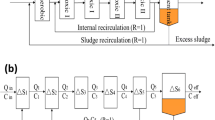Abstract
Nitrification by the obligately lithoautotrophic ammonia oxidizer Nitrosomonas eutropha was significantly inhibited when nitric oxide was removed from the culture medium by means of intensive aeration and turbulence. Nearly complete recovery of ammonia oxidation could be achieved by adding 100 ppm NO to the supplied air. Inhibition of ammonia oxidation occurred also upon addition of the NO binding agens 2,3-Dimercapto-1-propane-sulfonic acid (DMPS). Recovery of ammonia oxidation occurred within 3 h in the presence of 100 ppm NO and within 76 h in the absence of externally added NO. In co-cultures of N. eutropha and the NO detoxifying bacterium Pseudomonas PS88, hardly any nitrification was detectable and release of NO was extremely low when the heterotroph was provided with an organic substrate. When cells of Pseudomonas PS88 were added to a mixotrophically nitrifying culture of N. eutropha the release of NO decreased drastically upon the addition and ammonia oxidation ceased. These results confirm for the first time the significance of NO in the course of ammonia oxidation by N. eutropha.
Similar content being viewed by others
References
Anderson JH (1965) Studies on the formation of nitrogenous gas from hydroxylamine by Nitrosomonas. Biochim Biophys Acta 97: 337–339
Baumgärtner M (1991) Umsetzung von Stickoxiden (NOx) in Böden, auf Gebäudeoberflächen und in Mikroorganismen. Konstanzer Dissertationen Nr. 327, Hartung-Gorre, Konstanz
Baumgärtner M, Koschorreck M& Conrad R (1996) Oxidative consumption of nitric oxide by heterotrophic bacteria in soil. FEMS Microbiol. Ecol. 19: 165–170
Bock E; Schmidt S, Stüven R & Zart D (1995) Nitrogen loss caused by denitrifying Nitrosomonas cells using ammonium, or hydrogen as electron donors and nitrite as electron acceptor. Arch Microbiol 163: 16–20
Bodenstein M (1918) Die Geschwindigkeit der Reaktion zwischen Stickoxid und Sauerstoff. Z Elektroch 24: 183–201
Bradford M (1976) Rapid and sensitive methods for the quantitation of microgram quantities of protein utilizing the principle of protein dye binding. Anal Biochem 72: 248–254
Clark C. & Schmidt EL (1966) Effect of mixed culture on Nitrosomonas europaea simulated by uptake and utilization of pyruvate. J. Bacteriol. 91: 367–373
Drozd JW (1976) Energy coupling and respiration in Nitrosomonas europaea. Arch Microbiol 110: 257–262
Dua RD, Bhandari B, Nicholas DJD (1979) Stable isotope studies on the oxidation of ammonia to hydroxylamine by Nitrosomonas europaea. FEBS Lett. 106: 401–404
Ford PC, Wink DA & Stanbury DM (1993) Autoxidation kinetics of aqueous nitric oxide. FEBS Lett 326: 1–3
Galbally IE & Roy CR (1983) The fate of nitrogen compounds in the atmosphere. Dev Plant Soil Sci 9: 263–284
Hollocher TC, Kumar S & Nicholas DJD (1981) Oxidation of ammonia by Nitrosomonas europaea: definitive 18O-tracer evidence that hydroxylamine formation involves a monooxygenase. J Biol Chem 256: 10834–10836
Hooper AB & Nason A (1965) Characterization of hydroxylaminecytochrome c reductase from the chemotrophs Nitrosomonas europaea and Nitrosocystis oceanus. J Biol Chem 240: 4044–4057
Hooper AB (1968) A nitrite-reducing enzyme from Nitrosomonas europaea-preliminary characterization with hydroxylamine as electron donor. Biochim Biophys Acta 1962: 49–65
Hooper AB & Terry KR (1979) Hydroxylamine oxidoreductase of Nitrosomonas-production of NO from hydroxylamine. Biochim Biophys Acta 571: 12–20
Huie RE (1994) The reaction kinetics of NO2. Toxicology 89: 193–216
Kester RA, de Boer W & Laanbroek HJ (1997) Production of NO and N2O by pure cultures of nitrifying and denitrifying bacteria during changes in aeration. Appl Environ Microbiol 63: 3872–3877
Koschorreck M, Moore E & Conrad R (1996) Oxidation of nitric oxide by a new heterotrophic Pseudomonas sp. Arch. Microbiol. 166: 23–31
Lewis RS & Deen WM (1994) Kinetics of the reaction of nitric oxide with oxygen in aqueous solutions. Chem Res Toxicol 7: 568–574
Mancinelli RL & McKay CP (1983) Effects of nitric oxide and nitrogen dioxide on bacterial growth. Appl Environ Microbiol 46: 198–202
Miller DJ & Nicholas DJD (1985) Characterization of a soluble cytochrome oxidase/nitrite reductase from Nitrosomonas europaea. J Gen Microbiol 131: 2851–2854
Pires M, Rossi MJ & Ross DS (1994) Kinetic and mechanistic aspects of the NO oxidation by O2 in aqueous phase. Int J Chem Kin 26: 1207–1227
Poth M (1986) Dinitrogen production from nitrite by a Nitrosomonas isolate. Appl Environ Microbiol 52: 957–959
Remde A & Conrad R (1990) Production of nitric oxide in Nitrosomonas europaea by reduction of nitrite. Arch Microbiol 154: 187–191
Schmidt I & Bock E (1997) Anaerobic ammonia oxidation with nitrogen dioxide by Nitrosomonas eutropha. Arch Microbiol 167: 106–111
Schmidt I & Bock E. (1998) Anaerobic ammonia oxidation by cellfree extracts of Nitrosomonas eutropha. Antonie van Leeuwenhoek, 73: 271–278
Spector T (1978) Refinement of coomassie blue method of protein quantitation. Anal Biochem 86: 142–146
Stüven R, Vollmer M& Bock E (1992) The impact of organic matter on NO formation by Nitrosomonas europaea. Arch Microbiol 158: 439–443
Tsang DCY & Suzuki I (1982) Cytochrome c554 as a possible electron donor in the hydroxylation of ammonia and carbon monoxide in Nitrosomonas europaea. Can J Biochem 60: 1018–1024
Wink DA, Darbyshire JF, Nims RW, Saavedra JE & Ford PC (1993) Reactions of the bioregulatory agent nitric oxide in oxygenated aqueous media: Determination of the kinetics for oxidation and nitrosation by intermediates generated in the NO/O2 reaction. Chem Res Toxicol 6: 23–27
Wood PM (1988 a) Monooxygenase and free radical mechanisms for biological ammonia oxidation. In: Cole JA (ed) The Nitrogen and Sulfur Cycles. Cambridge University Press, Cambridge, pp 217–243
Wood PM (1988b) Chemolithotrophy. In: Anthony C (ed) Bacterial Energy transduction. Academic Press, London, pp 183–230
Wullenweber M, Koops H-P & Martiny H (1978) Der Einfluß von Nitrit auf den Verlauf des Wachstums von Nitrosomonas Stamm Nm1. Mitt. Inst. Allg. Bot. Hamburg 16: 159–164
Zart D & Bock E (1998) High rate of aerobic nitrification and denitrification by Nitrosomonas eutropha grown in a fermenter with complete biomass retention in the presence of gaseous NO2 or NO. Arch Microbiol 169: 282–286
Author information
Authors and Affiliations
Corresponding author
Rights and permissions
About this article
Cite this article
Zart, D., Schmidt, I. & Bock, E. Significance of gaseous NO for ammonia oxidation by Nitrosomonas eutropha. Antonie Van Leeuwenhoek 77, 49–55 (2000). https://doi.org/10.1023/A:1002077726100
Issue Date:
DOI: https://doi.org/10.1023/A:1002077726100




